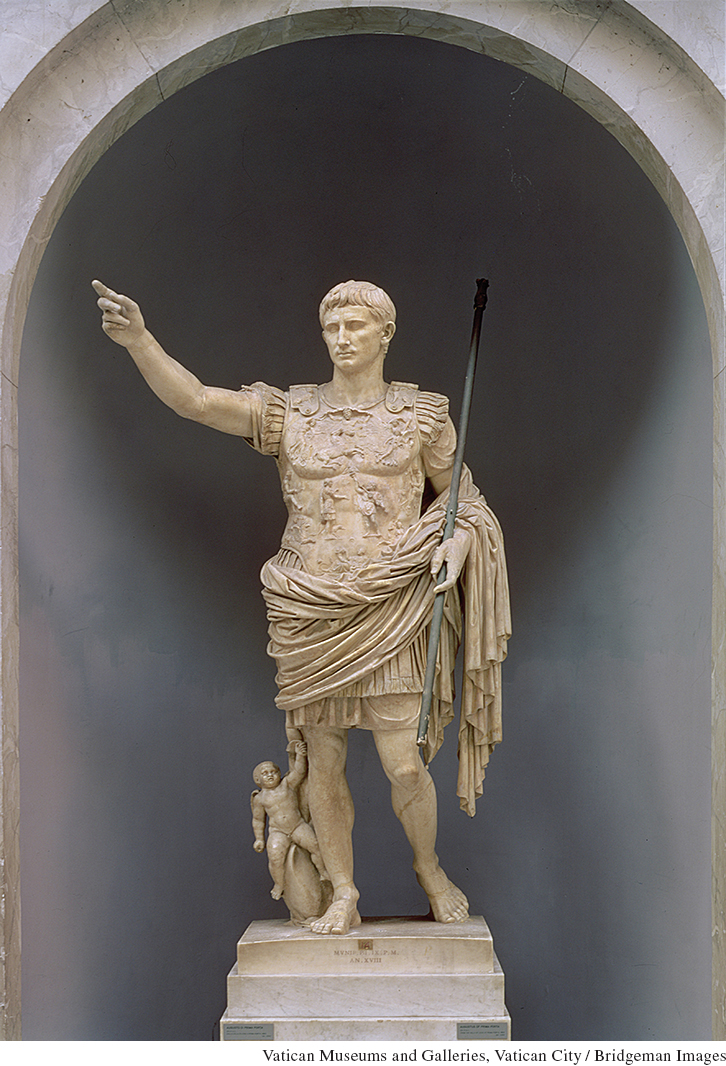Changes in Education, Literature, and Art in Augustus’s Rome
Printed Page 182
Important EventsChanges in Education, Literature, and Art in Augustus’s Rome
Elite culture changed in the Augustan period to serve the same goal as public entertainment: legitimizing the transformed political system. Orators skilled at speaking persuasively and critically lost their freedom of expression, as did artists. Under the republic, the ability to criticize political opponents in speeches had been such a powerful weapon that it could catapult a “new man” like Cicero to a leadership role. Now, the emperor’s dominance limited frank political debate or subversive art. Criticism of the ruler was very dangerous. (See “Seeing History: The Symbolism of Augustus as Ruler of the World.”)

With no public schools, only wealthy Romans received formal education. Most people learned only through working. As a character in a novel said, “I didn’t study geometry and literary criticism and worthless junk like that. I just learned how to read the letters on signs and how to work out percentages, and I learned weights, measures, and the values of the different kinds of coins.” Rich boys and girls attended private elementary schools to learn reading, writing, and arithmetic. Some went on to study literature, history, and grammar. Only a few boys then proceeded to study advanced literature and history, rhetoric, ethical philosophy, law, and dialectic (reasoned argument). Mathematics and science were rarely studied as separate subjects, but engineers and architects became proficient at calculation.
Scholars call the Augustan period the Golden Age of Latin literature. The emperor was the patron for writers and artists. Augustus’s favorite authors were Horace (65–8 B.C.E.) and Virgil (70–19 B.C.E.). Horace’s poem celebrating Augustus’s victory at Actium became famous for its opening line: “Now it’s time to drink!” Virgil’s epic poem The Aeneid became Rome’s most famous work of literature. Inspired by Homer, Virgil told the drama-filled story of the Trojan Aeneas, whom the Romans regarded as their heroic ancestor, as he established a community in Italy after fleeing from the burning ruins of his home city. Virgil balanced his praise for Roman civilization with the acknowledgment that peace existed at the cost of freedom.
Livy (54 B.C.E.–17 C.E.) wrote a history of Rome recording Augustus’s ruthlessness in the civil war after Caesar’s murder. The emperor only scolded him, because Livy’s work proclaimed that stability and prosperity depended on traditional values of loyalty and self-sacrifice. The poet Ovid (43 B.C.E.–17 C.E.), however, wrote Art of Love and Love Affairs to mock the emperor’s moral legislation with witty advice on sexual affairs and adultery. Ovid’s work Metamorphoses undermined the idea of natural hierarchy with stories of supernatural shape-changes, with people becoming animals and mixing the human and the divine. Augustus exiled the poet in 8 B.C.E. for his alleged involvement in the scandal involving the emperor’s granddaughter.
REVIEW QUESTION How did the peace gained through Augustus’s “restoration of the Roman Republic” affect Romans’ lives in all social classes?
Changes in public sculpture also reflected the emperor’s supremacy. Augustus preferred sculpture that had an idealized style. In the Prima Porta statue, Augustus had himself portrayed as serene and dignified, not weary and sick, as he often was. As he did with architecture, Augustus used sculpture to project a calm and competent image of himself as the “Restorer of the Roman Republic” and founder of a new age for Rome.